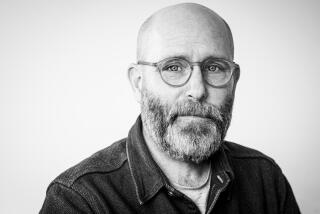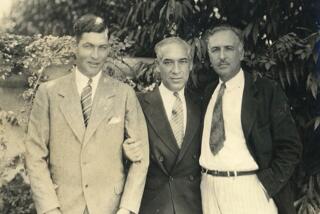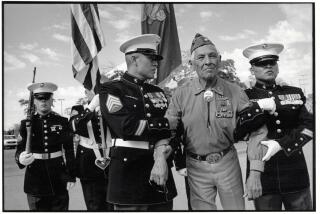George P. Horse Capture dies at 75; Native American curator
- Share via
When Native American activists from around the U.S. took over Alcatraz in 1969, George P. Horse Capture was a steel inspector for the state Department of Water Resources — a young man on his way to a solid career and ever further away from any sense of pride in his Montana reservation roots.
“I was very happy climbing that white mountain of success,” he once said. “But then I looked down over the top, and there was nothing there.”
The solution was to switch mountains. Joining the protesters for short periods over their 19-month stay, Horse Capture went on to become a passionate advocate for Native American culture and a museum curator who helped give his people an unprecedented voice in how their heritage would be presented and their artifacts displayed.
“He was profoundly important in contemporary American Indian history,” said Herman Viola, a longtime friend and curator emeritus of the Smithsonian’s National Museum of the American Indian in Washington, D.C.
Horse Capture, 75, died April 16 of kidney failure at his home in Great Falls, Mont., a family spokesman said. He was buried at Fort Belknap Agency Cemetery, on the reservation where he spent his early years. His tribe was the A’aninin, more commonly known as the Gros Ventre.
For Horse Capture, the explosion of Native American pride at the empty prison island in San Francisco Bay changed everything — including his name. Before Alcatraz, his last name was Capture — an adjustment his father had made to afford his children an easier time off the reservation.
Horse Capture also changed his career path. In 1974, he earned a bachelor’s degree in anthropology from UC Berkeley and, five years later, a master’s in history from Montana State University. The next year he joined the Plains Indian Museum of the Buffalo Bill Historical Center in Cody, Wyo., becoming one of the first Native American curators in the U.S.
‘He was a legend as a fellow museum professional,” said Rick West, president and chief executive officer of the Autry National Center of the American West in Los Angeles.
“He had a deep commitment to the contemporary Indian community,” said West, who was the founding director of the National Museum of the American Indian. “Before the last 20 years or so, native people were rarely consulted about material in museums and had a very tortured relationship with them. All of that got turned around during the era when George was active.”
In Cody, Horse Capture placed certain sacred artifacts in a room where only tribal elders or ceremonial leaders were permitted.
“He even installed a device that shut off the alarms so they could smoke or make a smudge while praying,” Viola said in his eulogy at Horse Capture’s funeral.
One day a Catholic priest insisted he be admitted.
“For God sakes, I’m a priest,” he said. “I want to go in there because there is sacred material.”
“I’m sorry,” Horse Capture said. “It’s not an exhibit area.”
“I’m a priest,” he said again.
“Wrong denomination,” Horse Capture replied.
In 1994, he moved to Washington, where he helped launch the National Museum of the American Indian.
In a congratulatory letter to the staff, he urged them to find inspiration in “the tribes that came from everywhere in unprecedented numbers” to take part in the museum’s dedication. “I have never seen such a thing before and they made me feel proud to be an Indian. … Now the buffalo has his nose firmly in the tipi. Before this moment, we didn’t even have a tipi. Celebrate it.”
Over the next 10 years, he held several high-level positions at the museum, taking firm stands on repatriating human remains and various artifacts to their tribes of origin. After his retirement, he continued consulting with various institutions. He also put together a massive digital archive on his tribe, delving into libraries and museums around the world for material.
Born on the impoverished Fort Belknap reservation on Oct. 20, 1937, George Paul Horse Capture was also known as “Nay Gyagya Nee,” or “spotted otter.” After graduating from high school and serving four years in the Navy, he enrolled in a Bureau of Indian Affairs relocation program and was sent to welding school in Los Angeles.
“Males had to become welders,” he later recalled. “Girls became beauticians.”
He is survived by his wife, KayKarol Horse Capture, and four children, George Jr., Joseph, Daylight and Peter, as well as the many grandchildren and great-grandchildren who knew him as “Grandpa Braids.”
His son Joseph Horse Capture is a museum curator specializing in Native American art. This month, he is leaving the Minneapolis Institute of Arts for the National Museum of the American Indian.
The elder Horse Capture was enthusiastic about pow-wows even in his final days, envisioning the afterlife with singing and drumming and dancing.
“Upon reaching the arena, one of his relatives would spot him and call him over,” his friend Viola recalled, and say: “‘George, what took you so long? We have been saving this chair for you. Sit down and enjoy the music.’”
More to Read
Start your day right
Sign up for Essential California for the L.A. Times biggest news, features and recommendations in your inbox six days a week.
You may occasionally receive promotional content from the Los Angeles Times.








